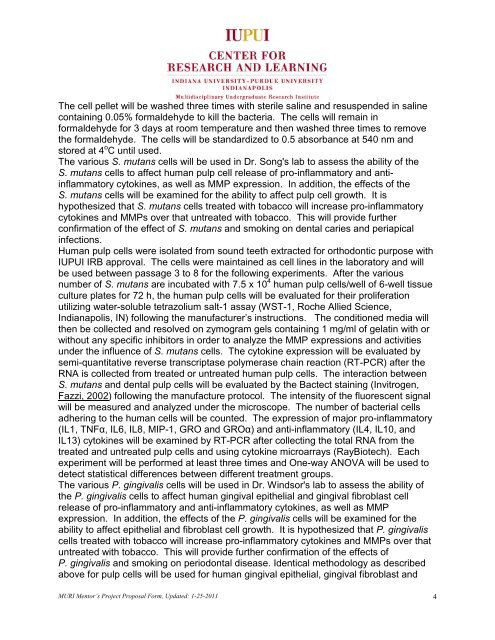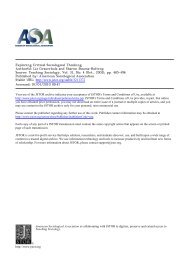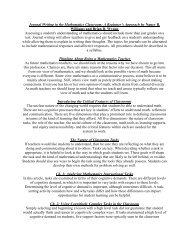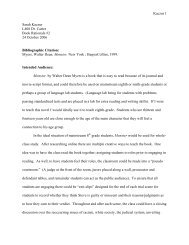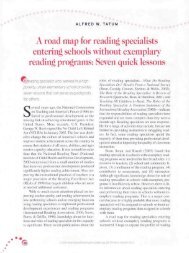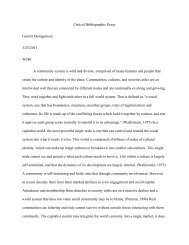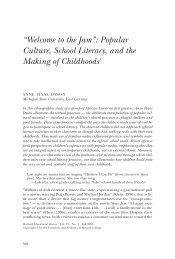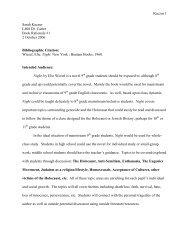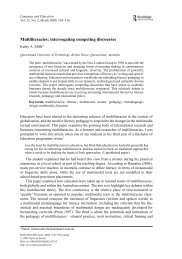Proposal - Oncourse - Indiana University
Proposal - Oncourse - Indiana University
Proposal - Oncourse - Indiana University
You also want an ePaper? Increase the reach of your titles
YUMPU automatically turns print PDFs into web optimized ePapers that Google loves.
The cell pellet will be washed three times with sterile saline and resuspended in saline<br />
containing 0.05% formaldehyde to kill the bacteria. The cells will remain in<br />
formaldehyde for 3 days at room temperature and then washed three times to remove<br />
the formaldehyde. The cells will be standardized to 0.5 absorbance at 540 nm and<br />
stored at 4 o C until used.<br />
The various S. mutans cells will be used in Dr. Song's lab to assess the ability of the<br />
S. mutans cells to affect human pulp cell release of pro-inflammatory and antiinflammatory<br />
cytokines, as well as MMP expression. In addition, the effects of the<br />
S. mutans cells will be examined for the ability to affect pulp cell growth. It is<br />
hypothesized that S. mutans cells treated with tobacco will increase pro-inflammatory<br />
cytokines and MMPs over that untreated with tobacco. This will provide further<br />
confirmation of the effect of S. mutans and smoking on dental caries and periapical<br />
infections.<br />
Human pulp cells were isolated from sound teeth extracted for orthodontic purpose with<br />
IUPUI IRB approval. The cells were maintained as cell lines in the laboratory and will<br />
be used between passage 3 to 8 for the following experiments. After the various<br />
number of S. mutans are incubated with 7.5 x 10 4 human pulp cells/well of 6-well tissue<br />
culture plates for 72 h, the human pulp cells will be evaluated for their proliferation<br />
utilizing water-soluble tetrazolium salt-1 assay (WST-1, Roche Allied Science,<br />
<strong>Indiana</strong>polis, IN) following the manufacturer’s instructions. The conditioned media will<br />
then be collected and resolved on zymogram gels containing 1 mg/ml of gelatin with or<br />
without any specific inhibitors in order to analyze the MMP expressions and activities<br />
under the influence of S. mutans cells. The cytokine expression will be evaluated by<br />
semi-quantitative reverse transcriptase polymerase chain reaction (RT-PCR) after the<br />
RNA is collected from treated or untreated human pulp cells. The interaction between<br />
S. mutans and dental pulp cells will be evaluated by the Bactect staining (Invitrogen,<br />
Fazzi, 2002) following the manufacture protocol. The intensity of the fluorescent signal<br />
will be measured and analyzed under the microscope. The number of bacterial cells<br />
adhering to the human cells will be counted. The expression of major pro-inflammatory<br />
(IL1, TNFα, IL6, IL8, MIP-1, GRO and GROα) and anti-inflammatory (IL4, IL10, and<br />
IL13) cytokines will be examined by RT-PCR after collecting the total RNA from the<br />
treated and untreated pulp cells and using cytokine microarrays (RayBiotech). Each<br />
experiment will be performed at least three times and One-way ANOVA will be used to<br />
detect statistical differences between different treatment groups.<br />
The various P. gingivalis cells will be used in Dr. Windsor's lab to assess the ability of<br />
the P. gingivalis cells to affect human gingival epithelial and gingival fibroblast cell<br />
release of pro-inflammatory and anti-inflammatory cytokines, as well as MMP<br />
expression. In addition, the effects of the P. gingivalis cells will be examined for the<br />
ability to affect epithelial and fibroblast cell growth. It is hypothesized that P. gingivalis<br />
cells treated with tobacco will increase pro-inflammatory cytokines and MMPs over that<br />
untreated with tobacco. This will provide further confirmation of the effects of<br />
P. gingivalis and smoking on periodontal disease. Identical methodology as described<br />
above for pulp cells will be used for human gingival epithelial, gingival fibroblast and<br />
MURI Mentor’s Project <strong>Proposal</strong> Form, Updated: 1-25-2011 4


